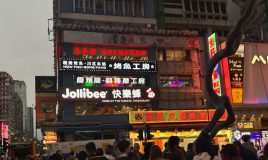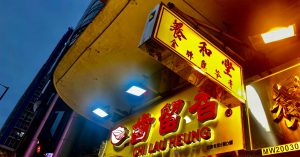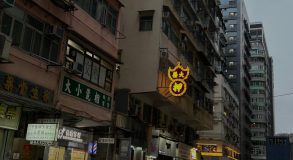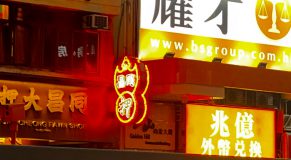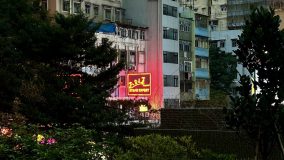Dohyun Kim:3036192536 Ez Kim:3036030788
Video Link: https://www.youtube.com/watch?v=RYx5DTLCbZM
Transcript:
Hello everyone and welcome to our video podcast! We are Dohyun Kim and EZ Kim from the University of Hong Kong. Okay so we’re going to dive right into our topic for today: vanishing neon signs. Let’s turn it over to Ez who’s broadcasting live outside.
Part 1: What are Neon Signs?
E: Wow, it’s so nice to be here. We are currently on Shanghai street at night time. The city is so vibrant, maybe it’s because of the vibrant atmosphere created by the neon signs. I feel like Neon lighting mainly constitutes the aesthetics and visual culture of Hong Kong’s streets.
Especially during the Golden Age, the soft neon lighting that spread throughout Hong Kong’s night scene was captured on film in dark, dense, disorderly, and futuristic painted backgrounds. This helped to form a unique Hong Kong film style. Although neon lighting stays at the center of the heart of Hong Kong people, they are quickly vanishing.
Part 2: The History of Neon Signs in Hong Kong: Why is it vanishing? How do we know that it will no longer exist in the near future?
E: Then why is it vanishing? Considering the history of neon signs, the golden age of neon began in the 1970s. Back then, there were neon lights everywhere. People competed to make the best neon lights and signs. But neon signs started to vanish. There were even masters, masters only for making neon signs, which shows a high degree of craftsmanship. Then why did these masters disappear?
E: There are a few reasons, firstly because of LED lights. LEDs are much cheaper, more efficient, and easy to install. They are also easy to mass-produce, but neon signs require a lot of technology and time to make and they take a longer time to master. In order to produce one neon sign, it takes 3-4 weeks, however, LED lights only take 1 to 2 hours, and does not need a master, meaning it is very cost efficient.
E: They are also disappearing due to problems with urban policy. The Hong Kong government has started raising safety concerns, especially large neon signs on the side of the road. The city has enacted safety regulations and started cracking down on signs. Thousands of signs have been removed in recent years, slowly changing the landscape of Hong Kong.
Part 3: What do we know about its past and present? i.e. What purpose/s does it serve?
E: So basically, many people see neon signs as a cultural heritage, so it feels really sad to go away. Neon signs are an icon for the past and present of Hong Kong. The colors, size and fonts which constitute the neon signs show the trend of Hong Kong back then
E: Looking at some famous examples of neon signs in Hong Kong, for example, the Sammy’s Kitchen, a steakhouse neon sign, they were known locally since 1979 for large, playful and idiosyncratic Angus cow neon signs.Unfortunately, due to its size, the sign was dismantled in 2014. Not only from this example, many famous neon signs have disappeared. It is important to remember that many neon signs can play a role as a reminiscence for many local families, between couples and friends, acting as a symbol for family union, friendship and love. Also, the vanishing neon signs show the decreasing artisan value of Hong Kong and craftsmanship, which shows how fast fashion is incorporating into the field of architecture.
Part 4: Who are and/or will be affected when it no longer exists? What are their feelings and attitudes toward this?
D: Thank you Ez. Next, who will be affected when the signs no longer exist? Firstly, for the shop owners that originally had the neon signs and had to have them removed have been emotionally and physically affected. An article by the Guardian mentions that traditionally shop owners had invested a lot in the neon signs because they wanted their shops to be inherited through generations after generations. For them, the neon signs were not only a sign post but the identity and soul of the business itself. Therefore, to take down the signs themselves meant to erase the essence of their shop from the customers. Mr. Tse, the owner of the famous Tai Tung Bakery recently had to take down their 50 year old neon sign. He was devastated by the need to do this and responded in an interview “I want Hong Kong to be vibrant. I want it to feel like Hong Kong.”
D: Secondly, for the local citizens that have grown up with the neon signs, this rapid disappearance of the city scape they used to see every single day will come to them as almost a loss of local identity. From an interview conducted with my local friends, they told me that it almost creates a sense of nostalgia and like the culture of the city is fading away. This is also due to the architecture of the city being featured in many famous Hong Kong films such as ChungKing Express or the Blade Runner. The signs have established an iconic atmosphere to the city, becoming part of the city itself.
D: Thirdly, the disappearance of neon signs also means the disappearance of jobs for tube Benders/neon sign makers in Hong Kong. There are actually only a few masters left in the city and even they are soon to retire. Meaning there will be no more masters to makeneon signs to carry on the legacy ever again. So does this mean an eternal disappearance of the once brightly flaming neon signs of Hong Kong?
Part 5: What is being done about its impending disappearance?
D: There have been many creative solutions that have been brought out to preserve the culture and history of neon signs in Hong Kong.
D: Recently The Hong Kong Polytechnic University’s Information Design Lab started a project that documents sketches of traditional sign boards to make it as a book to keep it archived as a record. Another shop named Neon Lite HK changed neon signs to A3 and A4 sizes so that people could keep them inside their homes. Another renowned establishment is “Chun Hing Neon Light,” which has been producing neon signs for decades and remains dedicated to preserving the art form. These companies not only cater to commercial clients but also undertake restoration projects to preserve the city’s existing neon heritage.
D: Local filmmakers also have not stayed silent. For example, in 2022, a film that highlights the widow of a neon sign master was released called “A Light Never Goes Out.” The film captured the disappearance and significance of the city’s neon signs, relating it with the recent major political changes. Not only this, local artists have tried to keep the signs alive by having exhibitions of neon sign installations, street artists graffiting the neon signs to the walls of the city, and even plays about the neon signs. Artists have tried to preserve the culture the neon signs hold, as a new art form than a commercial usage it used to have.
Conclusion/Ending Ment
Thank you for joining our podcast live from Shanghai Street. As we leave, we want to reminisce about the symbolism the neon signs carry.
Will this mean a significant change to the city’s architectural landscape? Perhaps it might mean a warning towards homogeneity, identical stores in every corner unlike the uniqueness and vibrancy Hong Kong streets used to hold. Removing the signs is like stripping off the clothes of Hong Kong, a crucial part of its identity that used to color the city with its familiar glow.
We will never know exactly how the city will change in the next decades. Until then all we can do is continue our efforts towards keeping the neon signs alive in our hearts of Hong Kong.
Research Resources Used:
https://www.theguardian.com/film/2023/may/09/a-light-never-goes-out-review-hong-kongs-neon-signs-light-up-nostalgic-drama
https://www.nytimes.com/2023/12/09/world/asia/hong-kong-neon-signs.html
https://www.discoverhongkong.com/eng/explore/culture/hong-kong-iconic-neon-signs.htm
5 Stills from the Video (Our Own Photos that we took from the Field Trip)
